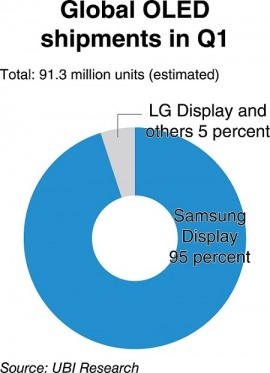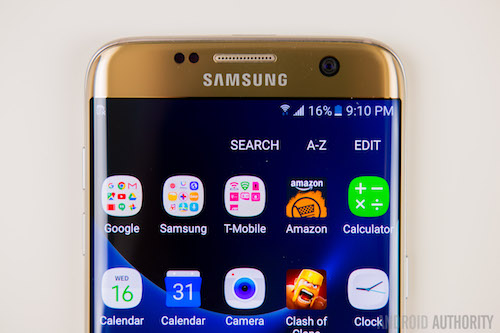Affiliate links on Android Authority may earn us a commission. Learn more.
Report: Samsung OLED display shipments double in Q1 2016
Published onJune 13, 2016

OLED panels have been a big thing for Samsung since the very first Galaxy S smartphone, and they have only gotten more and more advanced since then. The industry itself however, has largely avoided getting involved with organic panel production, sticking solid with LCDs. More recently however, there has been a larger awakening due to lowering costs and the pending build-up of more competition. Still, Samsung is seated on top of the table when it comes to market share, and a new report from Korea only seeks to confirm this.
According to a story on The Korea Times, by way of The Investor, local Korean market research firm, UBI Research, calculates that “Samsung’s OLED shipments have soared to about 86.7 million units in the first three months of this year” and that, of the total, “flexible OLEDs, which are used in Samsung’s latest Galaxy S7 Edge smartphone that has a curved screen, make up 14 percent of the company’s total shipments in the first quarter.”
More specifically, “Over the same period, total global OLED shipments surged to 91.3 million units, with Samsung making up a whopping 95 percent of this number.”
The report also makes reference to the fact that in Q1 2016, seventeen different handsets were announced that used OLED panels, “up from just five a year ago.”
“Samsung Electronics is extending its smartphone lineup with OLED displays and its Chinese rivals are also fast catching up,” said Yi Choong-hoon, the chief analyst of UBI Research.

LG Display was also mentioned, though with respect to television production. Currently the only LG smartphones to feature OLED displays are the G Flex and G Flex 2, as LG continues to couple its hardware devices with LCD technology. When it comes to television however, LG “saw shipments almost quadruple in the first quarter of this year”, something that likely has to do with a recent business arrangement to supply panels to China’s SKYWORTH.
One analyst, referred to as “Lee” (possibly a type-o, referring to Yi Choong-hoon, the chief analyst of UBI Research who was quoted earlier in the piece, or else the author, Lee Ji-yoon) had the following comments to make,
The global OLED market is dominated by Samsung and LG…But Chinese rivals are also beefing up OLED production for smartphones. Adding to AUO and BOE, other Chinese firms such as Visonox and Tianma started their own OLED production in the first quarter.
Samsung Display has big plans to push AMOLED, with The Korean Times stating that [Samsung’] A3 plant will raise production output from 15,000 units this year to an impressive 105,000 units per month by the end of 2017. To accomplish this, 1.8 trillion won, or roughly $1.5 billion, was invested into the facility.
Adding a final comment, Kim Dong-won, analyst at Hyundai Securities, said
Korea, Japan and Chinese display makers are all reducing LCD production while increasingly turning to OLED. OLED adoption among display makers and handset manufacturers is expected to further speed up as Apple’s iPhone is highly likely to feature an OLED display later in 2017.
Analysis
It is no surprise that Samsung’s share of OLED panels is quite substantial, especially as the company has made it a top priority to spent R&D on the technology behind it. In December of last year, a report came out that stated Samsung had a 95.8% of the OLED market, and this new report is essentially stating the same thing. The idea, thus, is that nothing has changed: Samsung is still in total control. What is of particular interest is the data related to flexible AMOLED displays.

As AMOLED becomes cheaper to make, and LCD technology gradually reduces further, it is likely there will be intense competition in this segment. It is unlikely Samsung will ever be able to keep the massive lead it currently has, but if the company can continue driving innovation and especially state-of-the-art flexible panels, it is likely to stay miles ahead. This could happen if the OEM can finally get its long-promised bendable project out in the market, something that stands to lose a lot of its thunder should a rival company like Lenovo bring a prototype to market first.
Wrap Up
With these latest figures to figure in, it’s clear that OLED is becoming more popular, and that Samsung is currently in control. This could all start to change going forward however. Be that as it may, we want to hear your thoughts on the issue! Drop a comment down below!